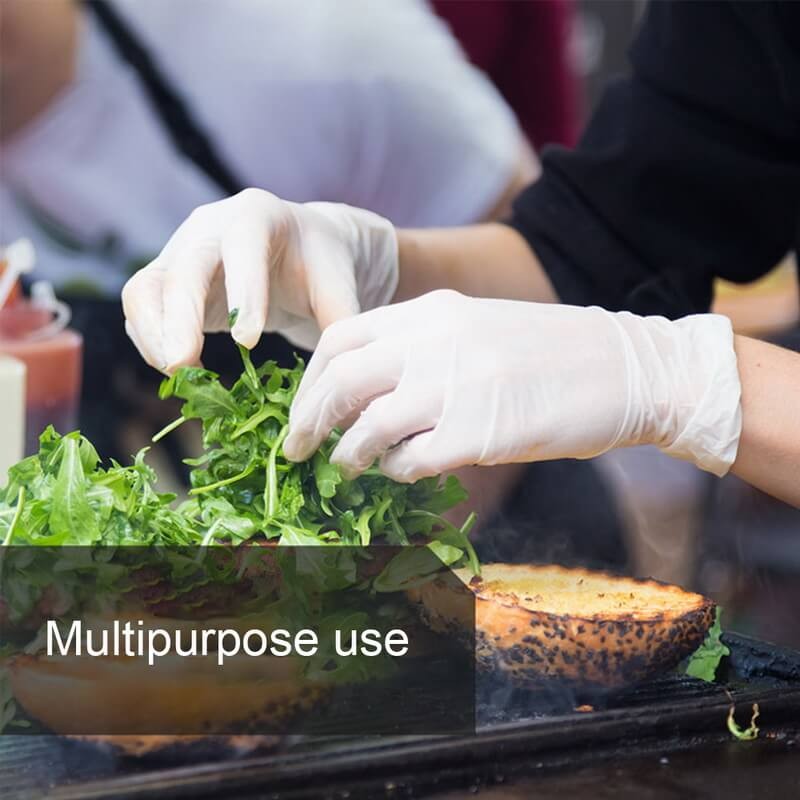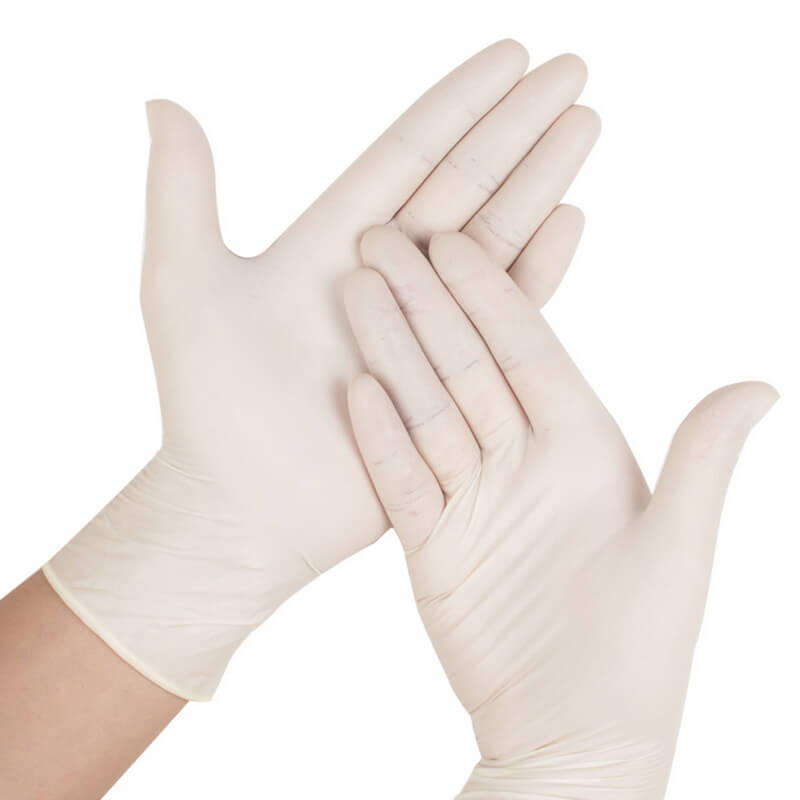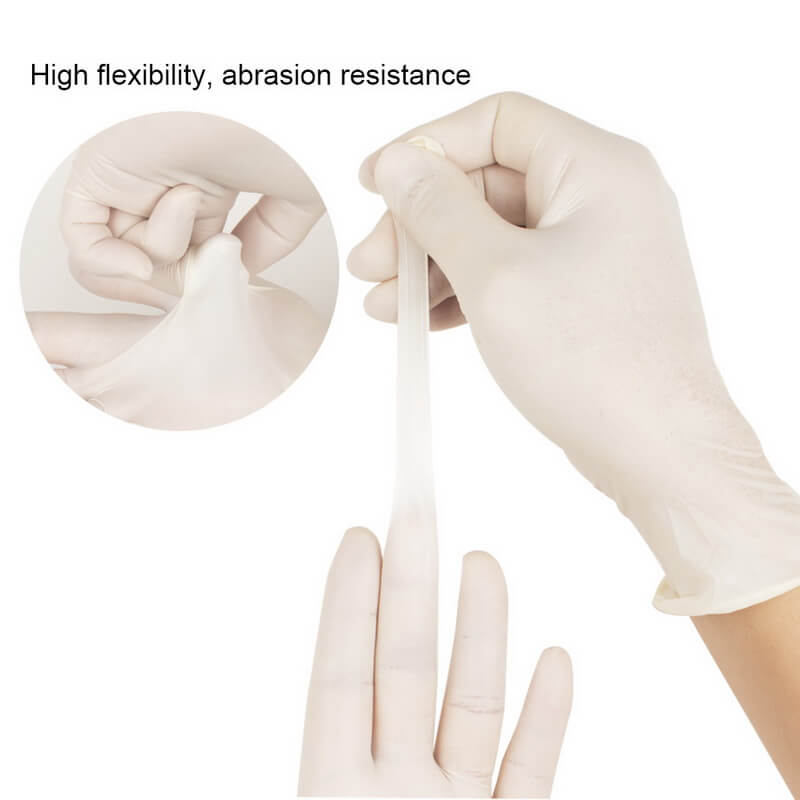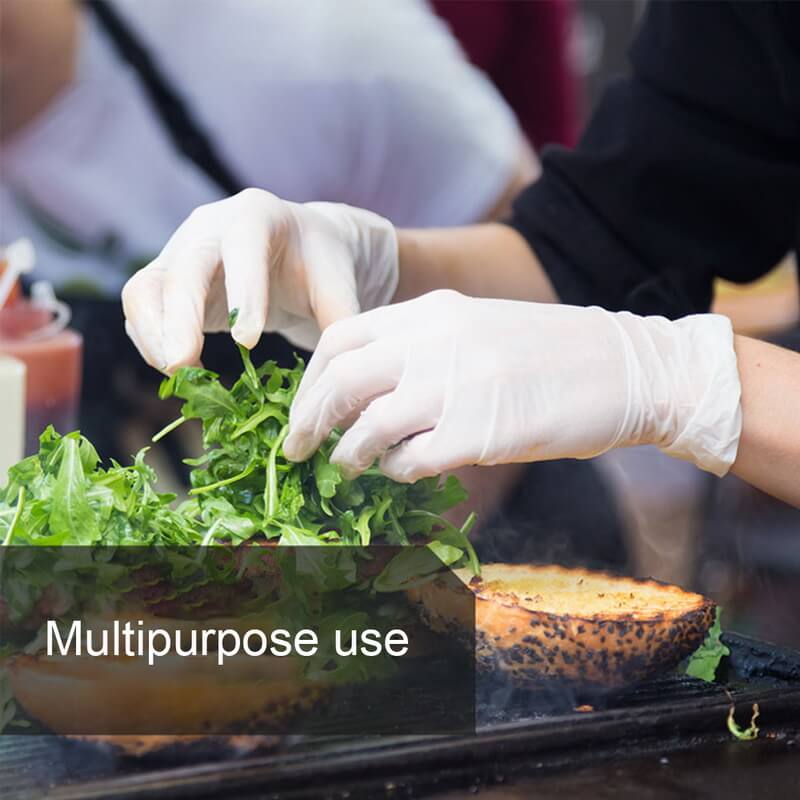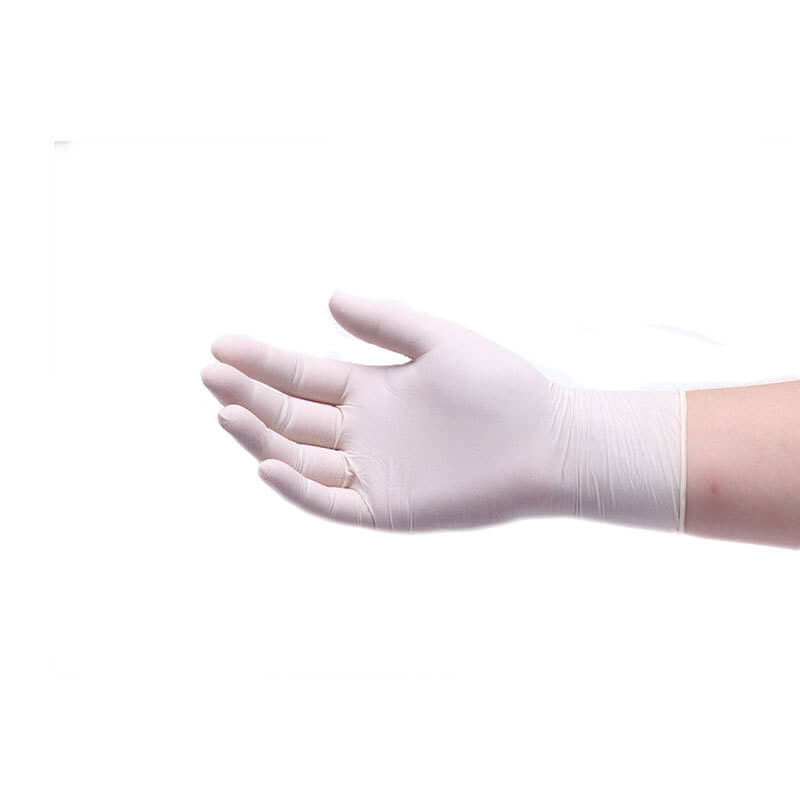OH&S præsenterer os med skinnende statistikker om håndulykker på arbejdspladsen. Det anslås, at mellem 40% og 60% af alle hændelser på arbejdspladsen er håndrelaterede. Mange af de skader, der er forårsaget, er et resultat af ikke at bruge engangshandsker eller ikke finde den perfekte pasform.
Der er forskellige typer handsker til forskellige opgaver, og det er vigtigt at kende de passende handsker til at bruge. Vi vil se på de forskellige typer engangshandsker, hvem der har brug for dem, og de situationer, hvor de bruges. (Lær mere: https://en.wikipedia.org/wiki/Medical_glove)
Hvad er engangshandsker?
Grundlæggende defineres engangshandsker som beskyttelsesbeklædning, der bæres over hænderne for at give beskyttelse. Disse handsker beskytter tommelfingre, fingre, håndled og andre dele af hånden mod stød, kemikalier, kropsvæsker osv. De er designet til engangsbrug og d erefter bortskaffelse.
Engangshandsker kan også defineres som PPE, der bæres for at beskytte hænderne mod farer på arbejdspladsen. Sådanne farer kan opstå som følge af kemiske eller biologiske væsker eller påvirkning, der kan føre til personskade. For at handskerne skal tilbyde beskyttelse, skal de være passende til opgaven og være lavet af de rigtige materialer.
Brugere af engangshandsker
Der findes forskellige typer af sikkerhedsmæssige handsker
Spørgsmålet er derfor, hvem der har brug for engangshandsker? Her er en liste over personale, der skal bruge engangshandsker:
- Medicinsk personale. Læger og sygeplejersker er forpligtet til at bære et par engangshandsker, før de passer til patienter. Dette er nødvendigt for at beskytte både patienten og den medicinske arbejder mod infektion.
- Akutmedicinsk tekniker / ambulanttekniker. De fleste gange er dette de første mennesker, der kommer i kontakt med ulykkesoffer. De skal bære engangshandsker, før de tager sig af sådanne ofre for at beskytte sig mod kropsvæsker.
- Laboratoriepersonale. Personer, der arbejder i laboratoriet, kommer i kontakt med flere kemikalier dagligt. Som et resultat heraf risikerer de at blive såret på grund af sprøjt eller spild af kemikalier.
- Fremstillingsindustrier. Personalet i fremstillingsindustrien, især dem, der fremstiller kemikalier og fødevarer, skal bære engangshandsker. Dette er vigtigt for at beskytte sig selv og i tilfælde af mad undgå forurening af maden.
- Olie- og gasarbejdere. Medarbejdere, der arbejder i olie og gas, udsættes for flere syrer, olier og organiske opløsningsmidler. Alle disse udgør en risiko for arbejdstageren, hvorfor der er behov for at beskytte deres hænder.
Situationer til brug af engangshandsker
Engangshandsker, som det ses ovenfor, kan bruges i en række industrier til håndbeskyttelse. Det er vigtigt at bemærke, at disse handsker er produceret med en specifik serviceklassificering. Som et resultat heraf bestemmer serviceklassen situationen for brugen af engangshandsker.
Nedenfor er nævnt nogle situationer, hvor engangshandsker bruges:
- Medicinsk brug. Handsker er meget vigtige for det medicinske erhverv, da de bæres for at undgå krydskontaminering. Sammen med dette er handsker nødvendige, når man håndterer følsomme materialer som kropsvæsker. Før handskerne gennemgås, gennemgår handskerne adskillige stadier af testning for at kontrollere for lækager, punkteringer og visuelle defekter.
- Brug af madservering. Der er visse handsker designet specifikt til brug i fødevareindustrien. De bæres af tjener, kokke og andet gæstfrihedspersonale. Disse handsker er nødvendige for at undgå krydskontaminering under tilberedning og servering af mad.
- Industriel anvendelse. Forskellige industrielle indstillinger kræver brug af engangshandsker til forskellige operationer. De er kendt som handsker i industriel klasse, og de bruges inden for landbrug, skønhed, luftfart, marine, auto, industrier. Handsker i industriel kvalitet er for det meste sort i farve, hvilket hjælper med at skjule snavs og også projicere bæreren som en professionel.
- Hjemmebrug. Engangshandsker kan også bruges under rengøring eller hjemmearbejde. I dette tilfælde kan de designes i enhver farve. Før du bærer handskerne, skal du kontrollere dem for punkteringer, tårer, brud og revner.
Fordele og ulemper ved engangshandsker
Engangshandsker hjælper med at beskytte hænderne mod adskillige farer på arbejdspladsen. Vi har allerede set på, hvem der har brug for handsker og de forskellige situationer, hvor de er nødvendige. Det er vigtigt at bemærke, at der er forskellige typer handsker.
For at overveje handskernes fordele og ulemper, skal vi overveje de forskellige typer. De forskellige typer engangshandsker er baseret på den type materialer, der anvendes til fremstilling af dem. Der er tre forskellige materialer, der anvendes til fremstilling af engangshandsker, og de er:
- Latex
- Nitril
- Vinyl
Vi vil se nærmere på handsker lavet af hvert af disse materialer i lyset af deres fordele og ulemper.
Latexhandsker: Fordele og ulemper
Latexhandsker er lavet af naturgummi, og de bruges mest mod tilfældig kontakt. Nogle af fordelene inkluderer:
- De er meget taktile, hvorfor de ses som det bedste valg til følsomme applikationer. Et levende eksempel på sådanne følsomme anvendelser er kirurgiske procedurer.
- Latex-handsker er meget holdbare, komfortable og fleksible. Derfor bruges de mest inden for det medicinske område.
- Perfekt til håndtering af vandbaserede og biologiske materialer.
- Billigere end de andre typer engangshandsker.
Ulemper ved latexhandsker inkluderer:
- De kan resultere i hudreaktioner og udløse allergier.
- Latex-handsker er ikke effektive med beskyttelse mod kemikalier. Derfor anbefales det ikke at bruge dem i procedurer, der kræver håndtering af organiske eller kemiske opløsningsmidler.
- Det er vanskeligt at finde punkteringer og lacerationer på latexhandsker, hvilket kan sætte bæreren i fare.
Vinylhandsker: Fordele og ulemper
Disse handsker er fremstillet af enten polyvinylalkohol (PVA) eller polyvinylchlorid (PVC). Lad os se på fordelene ved vinylhandsker:
- De udløser ikke allergier eller forårsager hudreaktioner som latexhandsker på grund af manglen på latex.
- Tilbydende beskyttelse mod kemiske spild og sprøjt. Af denne grund anbefales de til brug i laboratoriet.
- Ligesom latexhandsker er de behagelige og bløde at have på.
- De er også fleksible, stærke og har følbar følsomhed på grund af anvendelsen af nylige forskningsopdagelser.
Ulemperne ved vinylhandsker inkluderer:
- Vinyl er ikke så holdbar som nitril eller latex, hvilket gør disse handsker mindre ønskelige.
- Mindre følsomme over for berøring end andre materialer, der anvendes til fremstilling af handsker.
- Vinylhandsker håndterer ikke vandbaserede opløsninger og organiske opløsningsmidler godt.
Nitrilhandsker: Fordele og ulemper
Der er flere grunde til, at nitrilhandsker foretrækkes, især til generel brug. Lad os se på nogle af fordelene ved nitrilhandsker:
- Mere holdbar end både latex- og vinylhandsker.
- Lavet af tyndt materiale, så de er følsomme over for berøring.
- De er kemisk resistente og giver mere beskyttelse generelt.
- Tilbyder fremragende pasform, meget behagelig og også meget blød.
- De er perfekte til udvidet og tilfældig kontakt.
På trods af at der er så mange fordele, har nitrilhandskerne et par ulemper. To ulemper skiller sig ud, og de er:
- De har ikke så meget taktil følsomhed som latexhandsker.
- Nitrilhandsker koster langt mere at fremstille end latex- og vinylhandsker, og dermed deres dyre natur.
Design og struktur af engangshandsker
Engangshandsker, som vi nævnte i det foregående afsnit, er lavet af tre vigtigste materialer. Disse inkluderer nitril, latex og vinyl, men der er andre materialer såvel som neopren. I dette afsnit vil vi se på handsker i lys af det materiale, der udgør deres struktur.
For det første er her en tabel, der sammenligner de tre forskellige materialer med hensyn til design og unikke fordele.
| Handsketype | Definition | Fordel | Beskyttelsesniveau |
| Latexhandsker | Designet med naturgummi. | Bedste komfort, pasform, taktil følsomhed og fleksibilitet. | Vira, bakterier. |
| Vinylhandsker | Nogle gange er de kendt som syntetiske handsker, fordi de er fremstillet ved hjælp af et syntetisk materiale. | Syntetisk mulighed for latexhandsker, komfortable, omkostningseffektive. | Kemikalier. |
| Nitrilhandsker | Designet ved hjælp af syntetiske materialer. | Holdbar og elastisk. | Vira og kemikalier. |
With a clear understanding of the three different materials, we must explore more specific options. Each option comes with unique benefits that accrue to their users based on their design and structure. The distinct options have been explained in the table below:
| Glove option | Explanation | Advantage |
| Powdered gloves | The gloves are usually powdered using corn starch. | The powder makes donning of the gloves easier. |
| Powder-free gloves | In these gloves, the powder coating is completely removed. | Cleaner for use and doesn’t trigger as many allergies as powdered gloves. |
| Chlorinated gloves | These gloves are free of powder but are usually treated using chlorine. | Free of particles which reduces the risk of allergies. Easy to don. |
| Non-chlorinated gloves | The gloves are powder-free but make up for this with silicone/gel coatings. | Odor-free, neutral color, and possess long shelf life. |
| Examination gloves | Sterile and non-sterile grade medical gloves. | Protect the wearer from exposure to bodily fluids and blood. |
| Surgical gloves | Mostly sterile but very high-quality gloves for medical procedures. | Ensures protection against bodily fluids and blood. |
| Chemo gloves | These gloves are used for handling chemotherapy drugs and other chemicals after a series of tests. | Protects from exposure to chemicals. |
| Gloves with Aloe | They are coated with organic aloe. | It helps to keep the hands moisturized during use. |
| Gloves with oatmeal | The gloves are covered using colloidal oatmeal. | Prevents dry skin and protects wearers who already have dry skin. |
Testing for quality
It is impossible to discuss the design and structure of gloves without mentioning the tests they pass through during manufacture. Different disposable gloves are used for different purposes which is why they must pass through rigorous testing. Whether in health care or industrial applications, workers are exposed to all manners of risks.
Minimum quality standards
The standard for glove inspection is the “Acceptable Quality Limits (AQL). This is based on the prescription of the American Society for Testing and Materials (ASTM). The AQL testing method is applied to batches of gloves and it functions in terms of percentages.
For example, let’s say 100 gloves are to be tested using an AQL of 3.0. The standard allows just 3 gloves to fail the test in that batch. The standard for medical gloves is 1.5 or even lower in some cases.
Glove testing methods
Several levels of inspection go into the quality testing processes in glove manufacture. An example of such tests is the pinhole leak test. This test checks the glove for barrier integrity and determines if the test is good enough for medical procedures.
The test requires filling the gloves with a liter of water and closing them at the cuff. Following this, the gloves are hung upside down. If there are no leaks, the gloves are certified for use medically.
Gloves used industrially do not need to go through this sort of testing. Nevertheless, because manufacturers produce them on the same line with medical gloves, they pass through the same tests.
How effective are disposable gloves?
You find disposable gloves almost everywhere today, from the hospital to your favorite restaurant. They are worn as personal protective equipment to protect the hands from different kinds of hazards. The beauty of these gloves
One question begs to be answered, how effective are disposable gloves? We have put together a few points to show how effective these gloves are and why they are becoming indispensable.
- Protect against cross-contamination. In many workplaces like health care, emergency response, and food, cross-contamination is a huge risk. Bacteria and viruses can spread very quickly through this method.
During experiments in the lab, cross-contamination may alter results and render them inconclusive. With disposable gloves, such issues can be eliminated easily. You can change your hand protection easily and very quickly as you move from one patient or material to another.
The overall result of disposable gloves in this regard is that they ensure that you, your patient, and materials are protected.
- Prevent the spread of pathogens. Health care personnel, veterinary workers, and laboratory scientists come in contact with so many pathogens every day. Without adequate protection, they can quickly spread these pathogens to other people or surfaces that are used frequently.
With disposable gloves, these individuals can protect themselves from these pathogens. They will also protect their patients since they will be changing gloves after each patient.
The workers are even more protected when they don and doff the gloves using the prescribed procedures. Proper donning and doffing curbs the spread of pathogens and diseases by extension.
- Protection from unknown hazards. In every field, there are certain risks that workers are not aware of. Such unknown hazards may be more dangerous as their unknown effects may be far-reaching.
For example, a wildlife professional who makes contact with an animal carrying a toxic substance. The professional needs to wear disposable gloves because there is no saying what effects the unknown toxic substance may have. This is why it is important to wear disposable gloves when dealing with tasks that require compliance with PPE standards
- They don’t wear out. Now, this might be a bit confusing but their name gives the full details. They are designed to be disposable so they are disposed of immediately after each use. This could be moving from a patient to another, or a whole shift at the factory.
The gloves will not wear out since you don’t wear them over and over. Like we stated earlier, gloves in each industry have grades that determine their thickness. Such grades mean that the glove is designed specifically for the task you are carrying out.
With this, you rest assured that the gloves will see the task through. Since they are cost-effective, you can have as many as possible to work with as well.
How to select disposable gloves
Just picking up a pair of disposable gloves
The gloves should have undergone the required testing and must be approved. Asides satisfying the test requirements, there are a couple of factors that will help you make the right choice of gloves. We have listed the factors and explained them below.
Fabric or material
We have already told you the three different materials used in making disposable gloves. Along with this, we have shown you their pros and cons. From what we discussed above, nitrile gloves are seen as the most preferable because they are durable and don’t cause allergies.
Latex gloves are second in the ranking. While it is great that they are made from rubber, they may trigger allergies and unwanted reactions. If you are looking for the best fit, latex gloves are the best by a mile. Let’s not forget that they are tough, strong, and flexible.
If you are in search of a cost-effective pair, then you should choose vinyl. However, they are not as durable or as tough as the gloves mentioned above.
Service grade
The service grade of the gloves is a very important factor to consider before making a choice. You can decipher what industry the gloves will be used simply by checking the service grade. For example, gloves to be used in health care are graded by the manufacturer as medical gloves.
The same goes for gloves to be used in other fields. Ensure that you check to be sure that the gloves are designed for your kind of work before purchase.
Color
Each industry has a specific color of gloves identified with it. Health care, for example, favors white and blue gloves. This is because it is easier to identify punctures or cracks with these colors.
In industrial settings, it is very common to see black gloves. The reason for this is that black hides stains while adding a professional touch to the wearer.
Cost
You cannot discuss these factors without mentioning the cost of the gloves. How much are you willing and able to spend on the gloves? Check the market for different prices and then make your choice after striking a favorable bargain.
Proper way to use disposable gloves
There are best practices that govern the use of disposable gloves. Following this list ensures that you enjoy maximum protection while using the gloves. Here is a list of best practices to ensure you get the best from your disposable gloves:
- Always wash your hand before donning the gloves. This may seem counterintuitive but not washing your hands may lead to contaminating the gloves. It also means that if the gloves get torn during use, you are likely to spread germs. According to the CDC
- Check for tears, cracks, holes, or punctures before wearing. If you notice any of these, you should dispose of the gloves and get a new one.
- When the gloves start to look worn, replace them. The moment you notice degradation in the gloves, it is important to dispose of them. Get a new pair if you are not done with the task you are carrying out.
- Never wash and reuse disposable gloves. They are called disposable because you should dispose of them after use. You should only use them in the short term not use them multiple times.
- Always wear the right size of gloves. Your gloves should be the proper fit else your protection is compromised. This is because the gloves could get torn if they are too tight or fall off if they are too loose. Either way, you end up vulnerable to the hazards you sought protection against.
- Wash your hands when switching gloves. You must wash the hands using the CDC guidelines between gloves. This ensures that you don’t contaminate the new pair after taking off the old one.
- Watch out for allergies. If you are not sure if you are allergic to latex or not, stick to nitrile or vinyl gloves.
Conclusion
Engangshandsker er meget vigtige for at beskytte dine hænder i flere brancher. Da de er blevet meget populære, skal du lære at bruge dem rigtigt. I dette indlæg har vi vist dig de forskellige materialer, der bruges til at fremstille disse handsker og deres fordele og ulemper. Med ovenstående information mener vi, at du burde finde det lettere at vælge og bruge engangshandsker. (For mere information , se https://www.trendebut.dk .)





